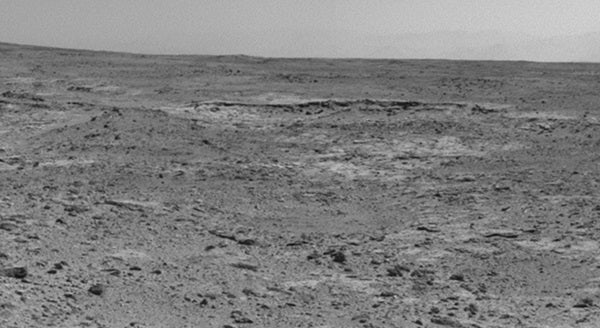When it drives autonomously, the rover chooses a safe route to designated waypoints by using its onboard computer to analyze stereo images that it takes during pauses in the drive. Prior to Monday, each day’s autonomous drive came after a segment earlier that day that was exactly charted by rover team members using images sent to Earth. The Sunday-Monday drive was the first time Curiosity ended an autonomous driving segment and then continued autonomously from that same point the next day.
The drives brought Curiosity to about 262 feet (80 meters) from “Cooperstown,” an outcrop bearing candidate targets for examination with instruments on the rover’s arm. The moniker, appropriate for baseball season’s end, comes from a named rock deposit in New York. Curiosity has not used its arm-mounted instruments to examine a target since departing an outcrop called “Darwin” on September 22. Researchers used the arm’s camera and spectrometer for four days at Darwin, and they plan to use them on just one day at Cooperstown.
Starting to use two-day autonomous driving and the shorter duration planned for examining Cooperstown serve to accelerate Curiosity’s progress toward the mission’s main destination — Mount Sharp.
In July, Curiosity began a trek of about 5.3 miles (8.6 kilometers), starting from the area where it worked for the first half of 2013 and heading to an entry point to Mount Sharp. Cooperstown is about one-third of the way along the route. The team used images from NASA’s Mars Reconnaissance Orbiter to plot the route and choose a few points of potential special interest along the way, including Darwin and Cooperstown.
“What interests us about this site is an intriguing outcrop of layered material visible in the orbital images,” said Kevin Lewis of Princeton University in New Jersey, a participating scientist for the mission who has been a leader in planning the Cooperstown activities. “We want to see how the local layered outcrop at Cooperstown may help us relate the geology of Yellowknife Bay to the geology of Mount Sharp.”
The team is using images taken from the vantage point reached on Monday to decide what part of the Cooperstown outcrop to investigate with the arm-mounted instruments.
The first day of the two-day drive began Sunday with about 180 feet (55m) on a southwestward path that rover drivers at NASA’s Jet Propulsion Laboratory (JPL) in Pasadena, California, evaluated ahead of time as safe. The autonomous-driving portion began where that left off, with Curiosity evaluating the best way to reach designated waypoints ahead. The vehicle drove about 125 feet (38m) autonomously Sunday.
“We needed to store some key variables in the rover’s nonvolatile memory for the next day,” said JPL rover driver John Wright. Curiosity’s volatile memory is cleared when the rover goes into energy-conserving sleep mode overnight.
The stored variables included what direction the rover was driving when it ended the first day’s drive and whether it had classified the next 10 feet (3m) in that direction as safe for driving. When it began its second day of driving, Curiosity resumed evaluating the terrain ahead for safe driving and drove 105 feet (32m), all autonomously.
This new capability enables driving extra days during multiday activity plans that the rover team develops on Fridays and before holidays.










